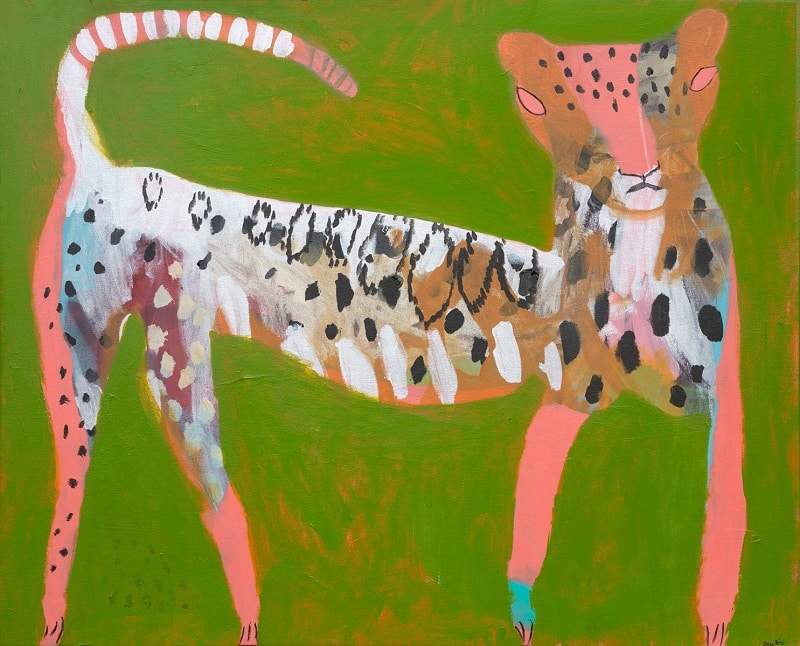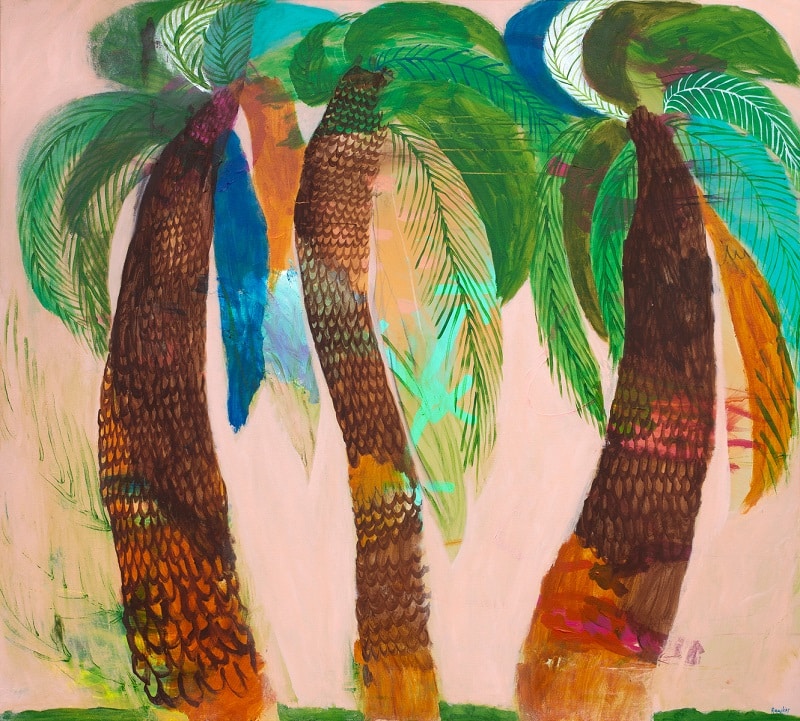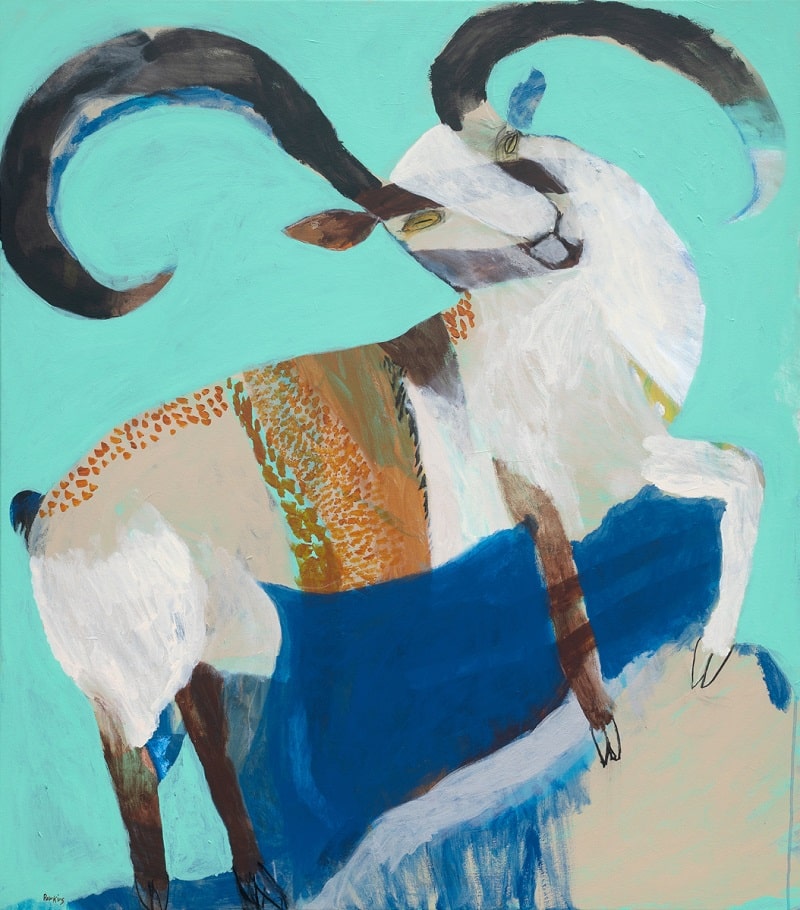Karlee Rawkins is a northern NSW-based artist and mother of three working in the field of painting, whose bright and beautiful depictions of birds, animals and flora, ruminate on the beauty and fragility of life.
The Other Side of the Mountain is an exhibition of new paintings that propose major life events and experiences can change the way we view the world, shape our beliefs and values, and transform the very essence of our being.
Rawkins has said the rationale of the children’s song ‘The Bear Went Over the Mountain’, which refers to overcoming an obstacle or a challenge, inspired the show’s title. In our interview, the artist elaborates on what inspires her paintings and articulates how her use of bird, animal and plant motifs, pose as symbolic representations of the human experience, and bring forth evocations of birth, death and spirituality, renewal and transformation, and our connection to the natural world.

What is it about birds and animals that inspires you to use them as symbolic representations of the human psyche?
I have always been attracted to nature imagery that is archetypal and mythological.
Throughout history and across cultures animal and plant imagery is used in ritual, ceremony and art to mark occasions and affirm who we are, how we exist. My work explores how we relate to this sort of imagery and how animals and plants can be used as metaphors for certain ideas.
Tell me about the creatures you have painted for this series. How do they inform the theme of human transformation, transition, change?
Animals are associated with certain powers and attributes, winged creatures are often used to represent the spirit or a shift in consciousness, imagery of birds and butterflies particularly. Certain animals are viewed as guides between realms, escorting souls to and from the spirit realm. So, these ideas led me to looking for particular imagery I could use. I was interested in representing transformation and transition, even great change such as death and birth.

What is the significance of representing animals that are mostly extinct?
I looked particularly at parrots to begin with, due to a personal association and story. I was shocked to discover the numbers of extinct birds, and the rate at which this is happening.
This led me to look more generally at all extinct species and the thought of using this imagery to suggest a different realm or experience, they are obviously not of this earth, anymore. They also remind us of the fragility of life and our environment, the beauty and vulnerability.
Your colour imaginings are beautifully bold and luminous. Do you work intuitively with colour or is it more of a considered process?
My process is intuitive however early on in a painting I play around with colour marks and patterns, and this tends to establish the colour relationships for each piece. I then strengthen that theme as I work. I am influenced by certain colour combinations, borrowing from nature; foliage, feathers, animal patterns and also vintage fabrics and old books that are faded or slightly mis-registered, like children’s stories or aged science books.
I play with warm and cold colours contrasting each other, slightly changed tones side by side as well. I create complexity in the layers, with translucency and metallics, spraying water and rubbing back. My attraction to bright and intense colours has always dominated my paintings. It is such a joy.
What about mark making, what tools do you use to illustrate your paintings and how do you approach a blank canvas?
I begin each piece by building up textures and random marks, this sets the colour scheme and gives a chance to explore combinations and pattern. Eventually a composition will start to suggest itself and I define, and then shift it around from there. I work with fairly rough brushes and rags and tend to work quickly with the application of layers. I then come back to define and tighten any edges or lines.

How do you strike a balance between your role as a mother and as a practicing artist?
My time management is next level! Between parenting three boys, and being a carer for my eldest as well, I need to be extremely careful with how I plan my time. Allowing completely focussed time to both parent or paint and work is so important to allow for this to be effective and enjoyable. I have done much integrating and cross pollinating… kids come into the studio, paintings I am working on hang in the house.
What does a typical day in the studio look like for you? Do you have any rituals to get yourself in the zone?
There is quite a process to getting set up and ready. I usually try to finish any morning jobs and anything that needs attending to then I open up the studio, all windows and doors and lighting. Gather my items like journal and the essential cup of tea. I have my favourite chair to sit on and view paintings I am working on and that really marks the beginning of a painting session. There are many other tasks that happen around my work as an artist, and they happen on designated days as well.
What have you gained artistically and/or spiritually through the creation of this body of work? And what do you hope to convey to your audience?
As is the case at the completion of any series, I feel a greater understanding of the themes of my work and excitement for the new that will come next. There is a clarity around the core interest of my practice being the exploration of transformation, how we tend to resist change but there is the possibility of positive outcomes.
I feel at this point in my practice I am actively distilling my work, my process and concepts. In terms of conveying a story to the audience, I hope to share a sense of reassurance, optimism, resilience and connection.
Visit Flinders Lane Gallery at The Nicholson Building, Level 1, Cnr Flinders Lane and 37 Swanston Street Melbourne to see ‘The Other Side of the Mountain’ in person. The gallery is open Tuesday to Friday, 10am to 6pm and Sat 11am to 5pm, or 3pm on the last weekend for de-install.
Images courtesy the artist and Flinders Lane Gallery